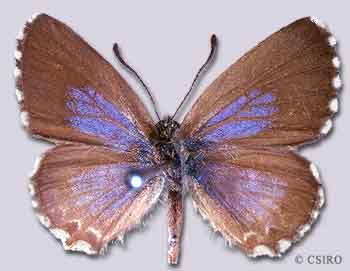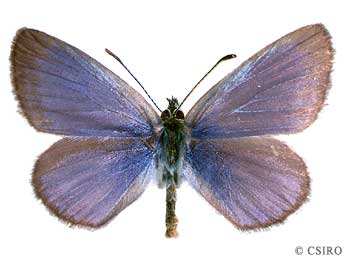
|
|
| ||||||||||||
|
Butterflies in this family are known as 'blues', although some species may be commonly known as 'coppers or hairstreaks'. The top surface of the wings on most of these butterflies is based on blue, although sometimes it may be purple or more rarely red. The upper surface wing colouring of these butterflies is seen during take-off and as they fly past; most species have a quick, short flight, which is characteristic of many butterflies in this family. Many colours may be present on the underside of the wings and is usually viewed when the butterfly is at rest. The caterpillars have a flattened appearance and may be green, blue, orange or dull brown in colour. Some species of Lycaenid caterpillars have an association with ants as they secrete fluids from a honey gland that is collected by the ant for food. Some species are even known to live in the nests of ants. Subfamily: Polyommatinae Adult members of this large subfamily usually have a flattened antennal club. Their larvae feed on flowers and flower buds, young leaves or seeds of a wide variety of plants. Some species are attended by ants.
Adults of the chequered blue butterfly have a wingspan of about 20 millimetres across and get their common name from the colour pattern of their wings. The major part of the upper side of both wings is brown in colour with blue towards the base and a terminal fringe chequered brown and white. The under side of both wings is predominantly a pale grey-brown with brown and white patterns. This species is found throughout much of Australia from southern and coastal Queensland through most of New South Wales and Victoria. In South Australia it occurs throughout most of the state particularly where its food plants grow. The larvae of the chequered blue butterfly feed mainly on the flowering heads and leaves of saltbush, but clovers, grasses and other shrubs are also known as food plants. As with many species of the Lycaenidae family the larvae closely resemble the flowering heads they feed on.
This species is considered to be the most common butterfly in Australia. Adults have a wingspan of approximately 25 millimetres across with pale purple-blue colouring on the upper side and a pale blue-grey underneath. The common grass blue butterfly can be found in large numbers in almost any open area, from the coast to high mountain habitats. It is common in suburban gardens and can even survive the most inhospitable industrial areas. They are present across most of Australia throughout the year but are more common in spring and summer in the cooler southern areas of the country. The caterpillars feed on both native and introduced legumes including saltbush, clover, lucerne and garden peas and beans. Subfamily: Theclinae This is one of the largest subfamilies in Australia. The butterflies in this family are characterised by having a cylindrical antennal club and wings in shades of iridescent blue, green, purple or orange on the upper surface and more cryptic patterns underneath. The larvae of most species secrete a substance that is attractive to ants and therefore are usually found in association with some ant species. The larvae of most species feed on young leaves, flowers of seeds of a wide variety of plants. For blue, copper or hairstreak species visit the Australian Insect Common Names - Lycaenidae section found here. |

